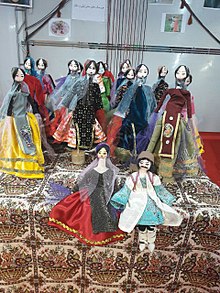Layli (Lurian doll)
Layli even Leili or Leyli ( lurisch = Layli لیلی) is a fold-dancing doll in Luri of Iran (especially Bakhtiar is popular and the Southern Luri).
etymology
The name Layli comes from Middle Eastern folklore and the love story Madschnūn Lailā . Layli is the symbol of the beloved who is spiritually beautiful.
Structure and function
Children can make the puppets dance by pulling a string tied to their hands. The construction of this hinge dummy is simple. The dolls have stylized faces, they differ mainly in the way they are dressed. Natural materials are used, which are complemented by sequins , glass beads, brocade borders or colored ribbons for the purpose of embellishment . Dolls and masks allowed common people to say things that were sanctioned in the real situation . For example, people criticized the politics and social conditions under Ahmad Shah Kajarthrough the puppet show without fear of punishment. Layli is a cultural tradition that is gradually disappearing in urban life in Iran.
Individual evidence
- ↑ Nikouei, A. and Sohrabi Nasirabadi, M. (2016) Study of the Importance of Contemporary Iranian Traditional Handmade Dolls and Puppets. Wacana Seni Journal of Arts Discourse, 15: 2761. doi : 10.21315 / ws2016.15.2
- ↑ Gorjian, F. 2010. The status of traditional handmade dolls (Layli or Bavig) in Lurish folklore .
- ↑ Azimpour, P. 2010. Farhang-e Aroosak-ha va Namayesh-haye Aroosaki-e Aeeni va Sonati-e Iran (Iranian Ritual and Traditional Puppets and Puppet Shows Dictionary). Tehran: Namayesh. Page 554
- ↑ Baird, B. 2002. Honar-e Arousaki (The Art of the Puppet). Translated to Persian by Javad Zolfaghari. Tehran: Nowruz-e Honar.
- ↑ Beyza'i, Bahram. 2004. Iranian theater. Tehran: Roshangaran. page 98

